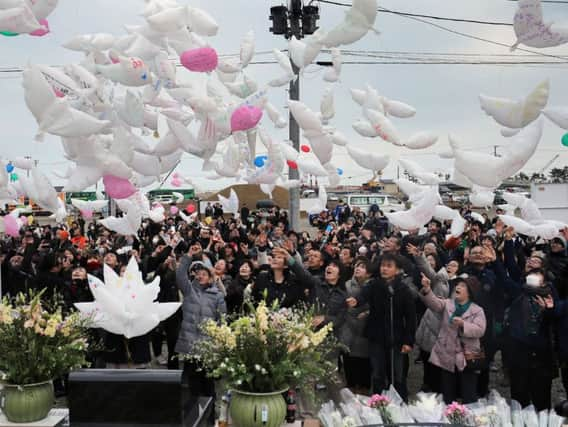Japan marks fifth anniversary of tsunami which killed 18,000


Some were close to tears as they held hands or bowed their heads in prayer as sirens sounded on a chilly afternoon in northern Japan. Emperor Akihito, Empress Michiko and the prime minister, Shinzo Abe led a ceremony in Tokyo attended by survivors.
“Many of the people affected by the disaster are ageing, and I worry that some of them may be suffering alone in places where our eyes and attention don’t reach,” the emperor said. “It is important all the people keep their hearts together so that not a single person still in difficulty is overlooked and they can return to normal life as soon as possible.”
Advertisement
Hide AdAdvertisement
Hide AdFive years on, the most heavily damaged communities have yet to be rebuilt. About 180,000 people are still displaced, including those reluctant to return to homes in Fukushima. Much of the disaster-hit Tohoku coast remains deserted, pocked by huge mounds of earth being used to raise the ground level before any rebuilding to minimise the threat from a future tsunami.
Mr Abe acknowledged many people were still struggling, but said “reconstruction is steadily making progress, step by step, with housing being rebuilt and jobs regained”.
Yesterday his cabinet approved a new 6.5 trillion yen (£40 billion) five-year reconstruction plan to 2020 to speed up construction of public housing for evacuees, and for health care, infrastructure and other projects.
At a Buddhist temple in the tsunami-hit city of Rikuzentakata, prayers were offered for the more than 1,700 residents who perished, including about 200 still missing.
“The best thing would be for things to go back as they were, but that’s not how the world works,” said Tadayuki Kumagai, 37, who lost his parents. He considers himself fortunate as their bodies were found. “Even if it’s impossible to go back to the way things were before the disaster, everyone hopes living standards will at least come closer to what they were,” he said. “That’s what rebuilding means.”
Housing is an acute problem, with some still in temporary accommodation, said Zuishu Sugawara, the temple’s chief monk. Forty-seven monks remain among the missing.